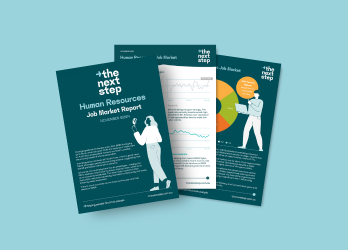Strategies for making progress in diversity, equity and inclusion
Despite best efforts, many Human Resources professionals are only seeing incremental improvements in workplace DE&I. Read on to discover effective strategies for making progress in diversity, equity and inclusion efforts.

The value of diversity, equity and inclusion
Diversity, equity, and inclusion are not just buzzwords or ‘nice to haves’; they are essential for building thriving workplaces that harness the power of different perspectives, backgrounds, and experiences.
As Secretary for Digital, and the NSW Department of Customer Service Emma Hogan shared at a recent Next Step webinar on DE&I, "We know that diverse teams drive better results. We know that they drive innovation. We know that they drive creativity."
Most importantly, Hogan believes that creating environments where people can thrive and do their best work has a profound impact on both culture and outcomes. "Remember that this is a very human journey," she says.
“An inclusive culture where there is strong sense of belonging is a game changer for companies, trying to retain their people,” agrees The Next Step Director Geraldine Doyle.
The changing landscape of DE&I
Many organisations have made great strides in improving diversity, equity and inclusion (DE&I), reshaping our workplaces for the better. That said, the consensus is that there’s still a long way to go.
Female board ASX100 board representation in Australia, for example, rose from 8.3% in 2009, to 38% in 2023. Gender diversity shows progress, yet underrepresentation in leadership roles and a significant 22.8% gender pay gap persist.
New and ongoing efforts are needed to help to level the playing field, dismantle biases and create equitable and inclusive workplaces. Workplace cultures must be designed to actively seek out, listen to and act upon perspectives of different ages, races, ethnicities, abilities, responsibilities, sexual orientation, neurovariance and more. Addressing gaps requires a continued and concerted commitment to DE&I.
Strategies for shifting the DE&I dial
To reap the benefits of diversity, equity, and inclusion and to really shift the dial, it's important to focus on actions that drive meaningful change. Below we capture insights from our recent webinar and highlight practical ways for making real headway in the DE&I space.
1. Lead with head and heart
Diversity Partners CEO, Dr Katie Spearritt recognises that strong, courageous leadership is essential for challenging the traditional status quo and that the greatest progress can be achieved when CEOs set bold aspirations and are genuine in their commitment. “We need leaders who can really stand up, set metrics, set clear expectations and consistently communicate the importance of DE&I,” she says.
Spearritt notes that Boards are becoming increasingly involved in this space (something she wasn’t seeing 10-years ago) and says that while executive leadership is essential for making SE&I headway, we all play a role in creating fair, inclusive and equitable workplaces.
2. Steer clear of tokenism
Beware of falling into the trap of tokenism, where efforts to foster diversity and inclusion feel performative rather than authentic. As D&I specialist Harleen Oberoi notes, "I think we need to move beyond the window dressing." She warns that tokenistic initiatives often miss the mark by not addressing deeper structural changes needed for meaningful progress. Targets, for example, risk ‘othering’ underrepresented groups, creating a fear that there is only one seat at the table and everyone must compete for it.
To shift the DE&I dial, Oberoi suggests looking beyond basic quotas and not only recruiting the right people, but also giving them a voice that is heard and counted. She also recommends being very clear about your ‘why’, aligning with core business goals and ingraining diversity, equity and inclusion across all aspects of the business.
3. Use data as a driving force
Data-driven diversity efforts hold great power. Metrics provide insights into where diversity is thriving and where gaps persist. However, be cautious. Data is not just about dashboards and percentages; it's about understanding and valuing people's stories and experiences.
While traditional DE&I metrics have centred around quotas and lag indicators, Harleen Oberoi recommends measuring the entire DE&I lifecycle of employees. This might include recruitment data, pulse surveys, employee feedback mechanisms, listening groups, performance evaluations, exit interviews, churn rates etc.
Setting key performance indicators for line managers, identifying other meaningful metrics and monitoring lead indicators can significantly advance your diversity, equity and inclusion efforts.
4. Prioritise culture ‘add’, not culture ‘fit’
Organisations typically seek to make a merit-based hires but should be careful about how they define merit. It’s easy to fall into a trap where ‘best fit’ is just a mirror of what’s come before. This unconscious bias simply reinforces the status quo. As Harleen Oberoi shared, the opposite of belonging is ‘fitting in’.
Rather than simply looking for people who "fit" the company's culture, it's better to find those who "add" to it. Dr Katie Spearritt encourages HR professionals and hiring managers to consider expand their notions of ‘best fit’. "I think we make great headway if all of us start talking about culture and how different people can add to the mix of the organisation," she advises.
5. Seek feedback & truly listen
Genuine DE&I progress requires a workplace culture that encourages employees to share their experiences and perspectives openly, knowing their opinions are valued and can make a difference.
Significant progress can be made by actively listening to employees, recognising their diverse needs, and adapting strategies accordingly. Such an approach fosters a sense of belonging, enabling organisations to create policies that truly cater to their workforce's needs. "Diversity is not just about bringing people in, it's about the experience of people," Dr Spearritt says.
At the NSW Department of Customer Service, Em Hogan sets the right tone by personally chairing the Diversity & Inclusion Advisory Council, which brings together the organisation’s twelve employee resource groups (ERGs). These groups, whether focused on indigenous and cultural diversity, LGBTQ+ inclusion, disability awareness, or other aspects of diversity, provide an opportunity for lived experiences to be shared and heard by Executive leaders and inform practices that impact the broader workforce.
6. Get your policies and procedures right
To make real headway in diversity, equity, and inclusion (DE&I) efforts, organisations must evaluate and adjust their policies and procedures, or as Dr Katie Spearritt calls it, their "hardwiring". She emphasises the significance of carefully assessing and adapting recruitment practices, performance evaluations, succession plans, and career development strategies to seamlessly weave DE&I into the core fabric of the organisation's operations.
Harleen Oberoi suggests delving into the 'so what?' aspect of policy implementation. By asking the tough questions and examining the impact of policies, it’s possible to deliver DE&I initiatives that are backed by real commitment.
Tapping into the knowledge and expertise of employee resource groups can be useful for identifying potential problem areas. “If we've got new policies coming out, we will often send them to colleagues and ask for the feedback,” Em Hogan says. “We ask: Have we missed any opportunities here? Should we be thinking differently? Is this policy too narrow?” Feedback is essential for constantly raising the bar. “Just when I think I'm getting somewhere, I realise I've still got so much to learn,” admits Hogan.
7. Harness the power of education & connection
Education plays a pivotal role in driving progress. Start with your leadership teams and frontline managers. This helps them recognise their role in embedding diversity and inclusion in the corporate strategy. Education should extend to all employees, promoting respect and understanding across the organisation.
Personal stories often have the most impact, serving as a bridge, fostering empathy and sparking conversations that move beyond data and statistics. When organisations share real stories of progress, achievements, struggles and human experiences, they create connections that resonates deeply. "The importance of storytelling cannot be underestimated,” says Dr Spearritt. “It highlights why someone feels they belong in an organisation; their success, when they've spoken up." These narratives illustrate the impact of DE&I efforts through relatable experiences, helping individuals better understand the significance of inclusion and equality.
8. Acknowledge privilege
An important aspect of diversity, equity and inclusion is recognising how advantages can shape perspectives. By acknowledging the privilege certain individuals hold due to their background or socioeconomic status, organisations can start conversations that lead to meaningful change.
Creating environments where employees can openly discuss privilege can be a powerful step toward promoting inclusivity. By confronting privilege, organizations can address biases and systemic barriers that impede inclusivity.
Are you ready to shift the dial?
Making real headway in diversity, equity, and inclusion requires more than just incremental change. Move beyond ‘cupcake days’ and seek-out other courageous people within the organisation. Influence leaders, seek-out culture "add" rather than culture “fit”, leverage the power of data and feedback, continue to refine policies, and share impactful stories across the organisation. Importantly, celebrate the progress you are making and keep human beings at the heart of it all.
All of us play an important role in fostering workplace environments where people can thrive and do their best work. Are you ready to help shift the DE&I dial?
How can we help?
To make significant progress in your DE&I efforts, having the right people in your HR function is crucial. Whether you're looking for DE&I specialists or HR generalists with a genuine passion for diversity and inclusion, we have the expertise to connect you with the right candidates.
"As a HR Recruitment specialist, we understand the importance of measuring not only skills and experience but also 'culture add'," says The Next Step Director Geraldine Doyle. “With our assistance, you can build a team of experts who are dedicated to driving positive change and fostering an inclusive workplace.
___
Glossary
Diversity in the workplace refers to the presence of a wide variety of individuals with distinct characteristics, backgrounds, and perspectives, such as differences in age, gender, race, ethnicity, sexual orientation, abilities, neurovariance and more.
Inclusion involves fostering an environment where all individuals, regardless of their differences, feel a sense of belonging, are valued for their contributions, and can fully participate and engage in all aspects of the workplace. It's about creating a culture that appreciates and actively seeks out diverse perspectives.
Equity, in a workplace context, is the commitment to ensuring fairness by recognising that different individuals have different needs and barriers. It involves providing the necessary support and resources to address those unique needs, enabling every employee to have equal access to opportunities, advancement, and success. Unlike equality, which treats everyone the same, equity considers the varying circumstances of individuals.



